 Review Article
Review Article
“Evaluating Educators’ Perspectives: A Study on Teachers’ Feedback Regarding the Implementation of the National Education Policy (NEP) 2020”
Rajkumari Soni1 and Shruti Tiwari2*
1Director CMIE (Centre of Multidisciplinary and Interdisciplinary Education), Associate Professor, Faculty of Management studies, Parul University, India
2Sr. Development officer CMIE (Centre of Multidisciplinary and Interdisciplinary Education), Professor in Design, Parul University, India
Shruti Tiwari, Sr. Development officer CMIE (Centre of Multidisciplinary and Interdisciplinary Education), Professor in Design, Parul University, India
Received Date: March 11, 2024; Published Date:April 17, 2024
Abstract
This research explores the perceptions and experiences of educators at Parul University with the implementation of the National Education Policy (NEP) 2020. The study aims to provide valuable insights into how teachers perceive and adapt to the changes introduced by the NEP 2020, with a focus on understanding the challenges and opportunities associated with its implementation. Through a comprehensive examination of educators’ perspectives, this research seeks to contribute to the ongoing discourse on educational reform and facilitate informed decision-making for effective policy implementation at the institutional level.
Aims and Objectives:
Assess Educators’ Awareness: Investigate the level of awareness among educators at Parul University regarding the key principles and
objectives outlined in the NEP 2020.
Evaluate Implementation Challenges: Identify and analyze the challenges faced by educators in integrating the NEP 2020 guidelines into
their teaching methodologies and curriculum planning.
Examine Pedagogical Changes: Explore the extent to which educators have adapted their pedagogical approaches to align with the
competency-based framework and multidisciplinary approach emphasized in the NEP 2020.
Investigate Infrastructure Readiness: Assess the infrastructure and technological readiness of Parul University to support the implementation
of NEP 2020, including digital resources, teacher training programs, and learning materials.
Gauge Teacher Satisfaction: Measure educators’ overall satisfaction with the NEP 2020 implementation and identify areas where
improvements or adjustments may be required.
It is hypothesized that educators at Parul University will exhibit varying levels of awareness and adaptation to the NEP 2020 guidelines. The study anticipates that challenges may arise in the implementation process, particularly in terms of adjusting pedagogical approaches, addressing infrastructure requirements, and navigating the shift towards a competency-based education system. Additionally, the hypothesis posits that educators’ satisfaction with the NEP 2020 implementation will be influenced by the level of support, resources, and professional development opportunities provided by the university.
Keywords:Indian higher education policy; Implementation strategies; Indian higher education system; Research and innovation focus
Introduction
The Government of India (GOI) created the National Policy on Education (NPE) to encourage education for all economic groups and include ordinary people in mainstream society. This strategy covers education from elementary school reading to higher education, with a concentration on specialization in both urban and rural settings. The GOI presented the first NPE in 1968, followed by a second policy in 1986, and a third significant change in 2020 by Prime Minister Narendra Modi (Govt. of India). Rizvi and Lingard (2009) suggest that countries aim to improve their educational systems.
National Educational Policy (NEP-2020) India aims to become a developed country by supporting the fourth goal of the United Nations Sustainable Development Goals (SDGs): ensuring inclusive and equitable quality education and promoting lifelong learning opportunities for all by 2030..
India’s new national education strategy 2020 aims to ensure equal access to high-quality education for everybody, regardless of social or economic background, by 2040. Our vision is to provide quality school and higher education to all citizens while upholding Indian values. We aim to transform the country into an equitable and vibrant knowledge society and global knowledge superpower by improving education quality at all levels. This will involve revising and overhauling the current education structure, including policies, regulations, and control systems [1,2].
The new policy, NEP-2020, is projected to be a full reform with less material and more problem-solving abilities.
Effective problem-solving requires creativity, interdisciplinary thinking, and a holistic approach to ensure unity and integrity. The policy aims to improve education pedagogy by making it more experimental, inquiry-driven, learner-centered, analysis-based, flexible, enjoyable, and futuristic. This will support countries’ economic growth, social justice, scientific advancement, cultural preservation, and national integration.
In July 2019, Aithal P. S. et al. published a paper titled “Analysis of Higher Education in Indian National Education Policy Proposal 2019 and Its Implementation Challenges.” The paper reviewed the literature on Indian Higher Education Policies and Their Consequences, salient features, and their focus on the draft National Education Policy 2019 through content analysis. The report compared suggested policies for higher education to prior policies. The report analyzed the impact of the NEP 2019 plan on private and state higher education institutions, including facilities and limits. The new policy proposal’s strengths and flaws are evaluated and presented based on numerous stakeholders [2].
In August 2020, Aithal, P. S. et al presented a study titled “Analysis of the Indian National Education Policy 2020 toward achieving its Objectives.”
This article compares new policies in higher education to present practices. This article discusses the potential benefits and innovations of NEP 2020 for the Indian higher education sector. Suggestions are provided for successful implementation to achieve the objectives [3].
Suryavanshi, S. (2020) compared teacher education in Indian and Chinese universities and found that autonomy is crucial for faculty and institutional leaders to innovate in teaching, research, and service. According to the report, NEP-2020’s proposal for individual autonomy at universities is a positive step forward [4].
Deb, P. (2020) released an essay titled “Vision for Foreign Universities in the National Education Policy 2020: A Critique” that examines the globalization of Indian higher education, which is one of the declared goals of the NEP 2020 [5].
About NEP-2020
The National Education Policy 2020 aims to create an equal, sustainable, and thriving knowledge society by merging India’s traditions, culture, values, and ethos into the education system. The NEP-2020 builds on the country’s rich history and the contributions of academics to provide high-quality multi-disciplinary liberal education at all levels, including school and higher education. The goal is to increase the gross enrolment ratio (GER) of school and higher education enrolment from 28% and 05% to 50% and 20%, respectively, by 2030. This will require significant changes in education policies and governance systems, including the implementation of accountability measures (Figure 1).
NEP 2020 feedback on Curriculum: Learning Outcomes of the Different Vertical of Courses:
a. Major Courses - To provide students to pursue in-depth
study of a particular subject/discipline.
b. Minor Courses - To provide students with a broader
understanding beyond the major subject/discipline.
c. Multidisciplinary (University Elective) Courses - To
broaden the intellectual experience and form part of liberal arts
and science education.
d. Skill Enhancement Courses - To impart practical skills,
hands-on-training, soft skills to enhance the employability of
students.
e. Ability Enhancement Courses - To acquire and
demonstrate the core linguistic skills, including critical reading
and expository and academic writing skills, that help students
articulate their arguments and present their thinking clearly
and coherently and recognize the importance of language as a
mediator of knowledge and identity [6,7].
f. Value Added Courses - To provide students an
understanding of the expectations of industry, improve
employability skills of students, bridge the skill gaps, and make
students industry-ready, provide an opportunity for students
to develop interdisciplinary skills, and mold students as job
providers rather than job seekers [8] (Figure 2).
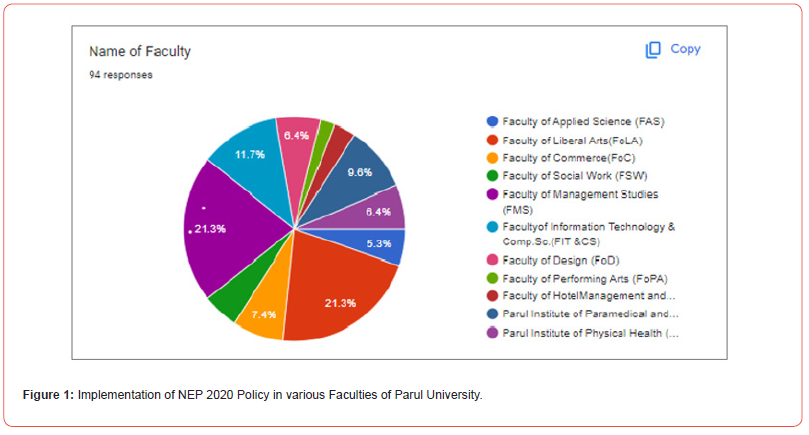
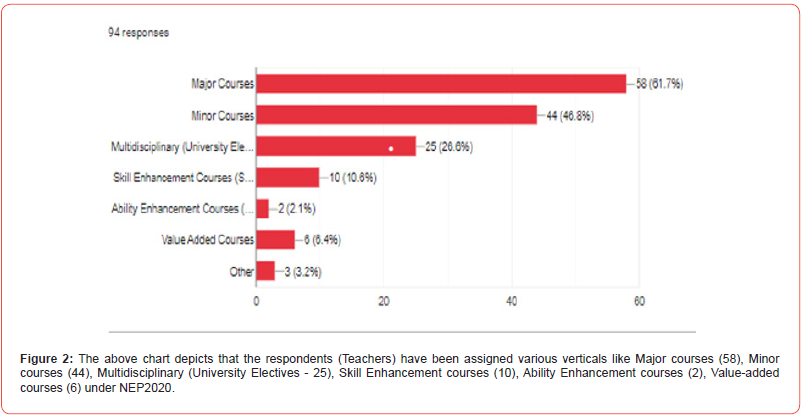
A survey has been conducted among 100 teachers engaged in teaching in the first semester of 11 Faculties of Parul University, to understand their views and experiences regarding the implementation of the National Education Policy (NEP) 2020 in Parul University. The feedback from the teacher is essential for our continuous improvement which will help us to improve the quality of education and enhance our learning outcomes (Figure3).
It is evident from the above chart that out of 11 faculties, PIHMTC – 25% , PIA – 27% , PIC – 43% , PISW – 80% , PIPH – 33% , PIPHS – 44% strongly agree, and PIAS – 25%, PIHMCT -50%, PIA – 59%, PIC – 29%, PISW -20%, PIPA – 83%, PIPH – 50%, PIPHS – 45%, PID – 76%, PIBA – 100%, PICA – 84% agree whereas, [9,10] PIAS – 50%, PIA – 9%, PIC – 29%, PIPH - 17%, PIPHS – 11% were found neither agree nor disagree, and PIAS – 25%, PIHMT – 25%, PIPA – 17%, PID – 26%, PICA – 16% respondents were not agree with the appropriate allocation of credits to the courses in different verticals of courses as per NEP 2020.
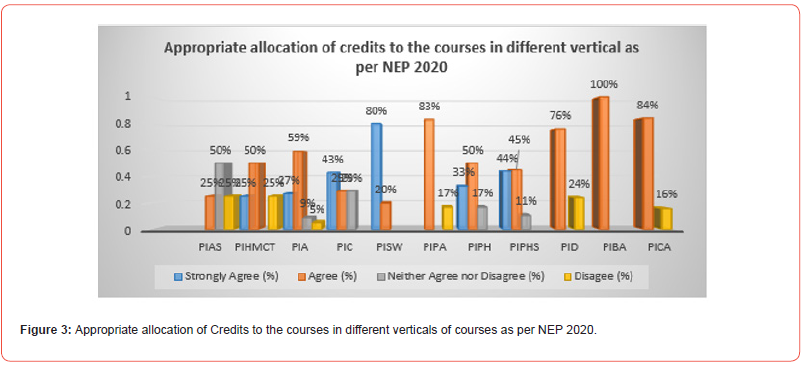
(Figure 4) It has been observed in the above chart that the respondents (Teachers) from the faculties of PIAS – 33%, PIHMCT – 66%, PIA – 73%, PIC – 86%, PISW, PIPA, PIPH, PIPHS, PID – 100%, PIBA – 90%, PICA -84% have been involved as a part of team in the curriculum design whereas, respondents from PIAS - 66%, PIHMCT – 33%, PIA – 27%, PIBA – 10%, PICA – 16% were not a part of the team while curriculum designing [11,12].
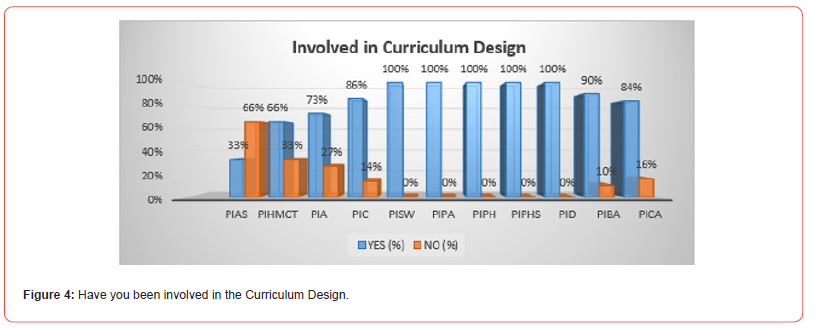
(Figure 5)The above chart shows that the respondents (Teachers) from the Faculties of PIAS – 66%, PIHMCT – 66%, PIA – 32%, PIC – 57%, PISW – 80%, PIPA – 33%, PIPH – 50%, PIPHS – 22% strongly agree that the present curriculum given in NEP 2020 is providing holistic development of students, and 33% - PIAS, 33% - PIHMCT, 64% - PIA, 48% - PIC, 20% - PISW, 17% - PIPA, 33% - PIPH, 78% - PIPHS, 100% - PID, PIBA, PICA respondents (Teachers) are agree to the same, whereas the respondents (Teachers) from PIA – 4%, 50% - PIPA – 50%, PIPH – 17% are neither agree nor disagree with the concept of holistic development.
(Figure 6)It is depicted from the above chart that the respondents (Teachers) from the Faculties of PIAS – 33%, PIHMCT – 66%, PIA – 27%, PIC – 14%, PISW – 80%, PIPH – 33%, PIPHS – 11% strongly agrees and the respondents from PIAS – 66%, PIHMCT – 33%, PIA – 59%, PIC – 86%, PIPA – 50%, PIPH – 50%, PIPHS – 78%, PID – 60%, PIBA – 100%, PICA – 92% agrees that the courses and course content enhances the complex problem – solving skills in students [13]. Whereas respondents (Teachers) from PIA – 5%, PIPA, PIPH – 17%, PIPHS – 11% are neither agree nor disagree, and the respondents from PIA - 5%, PIPA – 33%, PID – 40%, PICA – 8% completely disagree with the above thought.
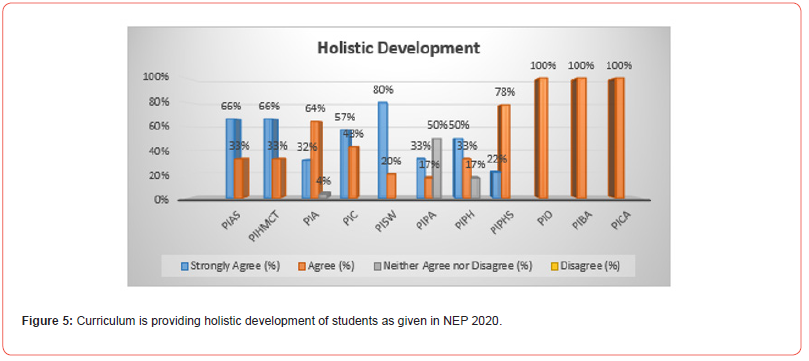
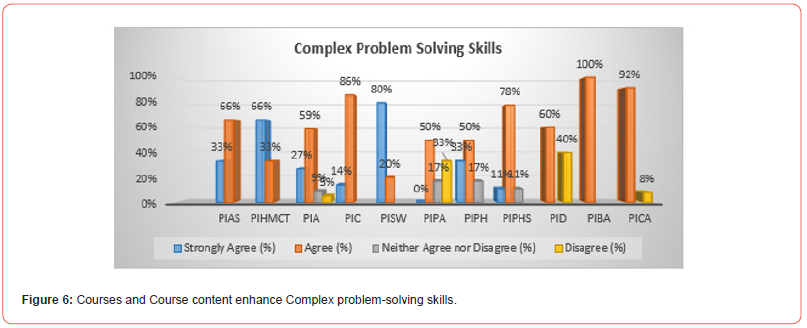

(Figure 7) It is evident from the above chart that the respondents (Teachers) from the Faculties of PIAS – 33%, PIA – 46%, PIC – 57%, PISW – 100%, PIPA, PIPH – 17%, PIPHS – 33% strongly agree, and the respondents from PIAS – 66%, PIHMCT, PID, PIBA – 100%, PIA – 36%, PIC – 14%, PIPA – 83%, PIPH – 67%, PIPHS – 56%, PICA – 92% agrees that the courses and course content helps the students to demonstrate the ability to creativity. Whereas respondents from PIA – 18%, PIC – 14%, PIPH – 16%, PIPHS – 11% neither agreed nor disagreed, and 8% - PICA disagreed with the same.
(Figure 8) It is being observed that the respondents (Teachers) from the Faculties of PIAS – 33%, PIHMCT, PIPH – 33%, PIA – 32%, PIC – 43%, PISW – 80%, PIPA – 50%, PIPHS – 11% were strongly agreed, and the respondents from PIAS – 66%, PIHMCT – 33%, PIA – 50%, PISW – 20%, PIPA – 33%, PIPH – 50%, PIPHS -78%, PID – 88%, PIBA – 100%, PICA – 76% agreed that the courses and course content enhance the analytical reasoning/ thinking skills of the students.
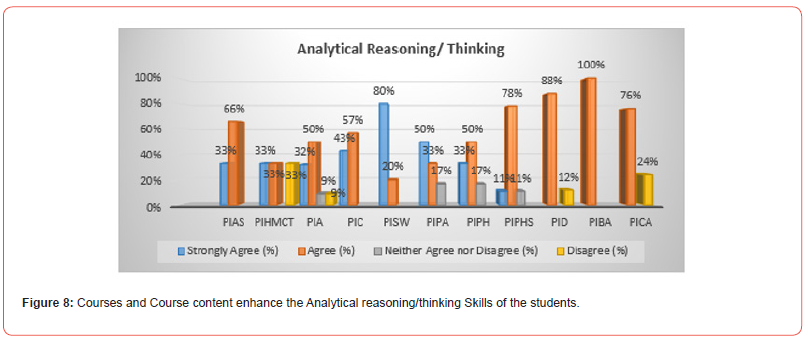
(Figure 9) The above chart shows that the respondents (Teachers) form the Faculties of PIAS – 33%, PIA – 41%, PIC – 14%, PISW – 80%, PIPA – 17%, PIPH – 97%, PIPHS – 11% were strongly agreed, and the respondents from PIAS – 66%, PIHMCT – 66%, PIA – 36%, PISW – 20%, PIPA – 83%, PIPH – 16%, PIPHS – 67%, PID – 88%, PIBA – 100%, PICA – 84% were agreed that the courses and course content enhance the research related skills of the students. Whereas the respondents from PIA – 14%, PIC – 43%, PIPH – 17%, PIPHS – 11% were neither agreed nor disagreed, and the respondents from PIHMCT – 33%, PIA – 9%, PIPHS – 11%, PID – 12%, PICA – 16% completely disagreed with the above thought.
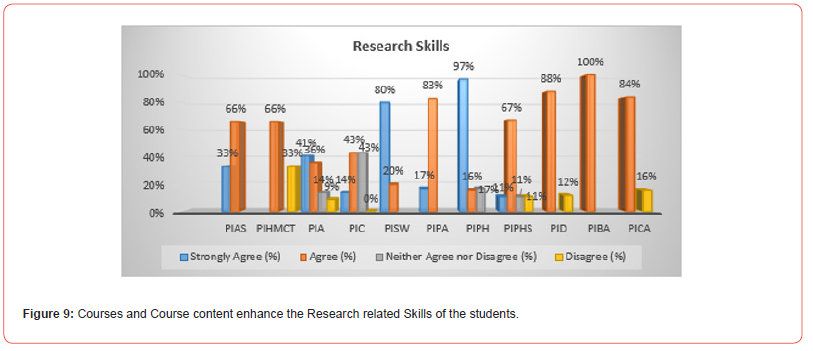
(Figure 10) It is depicted from the above chart that the respondents (Teachers) of the Faculties of PIA – 32%, PIC – 14%, PISW – 80%, PIPA, PIPH – 33%, PIPHS – 11%, and the respondents from PIAS -66%, PIHMCT – 33%, PIA – 50%, PIC – 43%, PISW – 20%, PIPH – 50%, PIPHS – 78%, PID – 88%, PIBA, PICA – 100% were agreed that the courses and course content as per NEP 2020 enhance the leadership readiness/ qualities skills of the students. Whereas the respondents from PIA – 14%, PIC – 43%, PIPA, PIPH – 17%, PIPHS – 11% were, neither agreed nor disagreed, and respondents from PIAS – 33%, PIHMCT – 66%, PIA – 5%, PID – 12% have completely disagreed with the above thought.
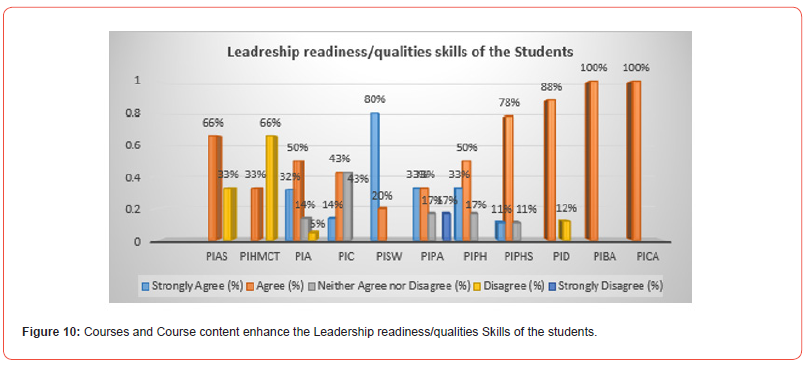
(Figure 11) It is being observed that the respondents (Teachers) from the Faculties of PIAS - 50%, PIHMCT – 33%, PIA – 36%, PIC – 57%, PISW – 80%, PIPA – 33%, PIPH – 50%, PIPHS – 11% were strongly agreed, and the respondents from PIAS – 25%, PIHMCT – 66%, PIA – 59%, PIC – 43%, PISW – 20%, PIPA – 50%, PIPH – 17%, PIPHS – 89%, PID – 88%, PIBA, PICA – 100% were agreed that the courses and course content helps the students to learning skills. Whereas 5% - of PIA, 33% - of PIPH respondents were neither agreed nor disagreed, and respondents from PIAS – 25%, PIPA – 17%, PID – 12% have been completely disagree with the above thought.
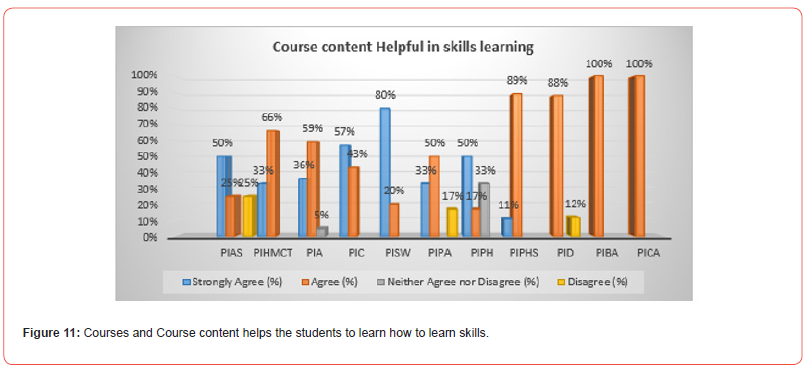
(Figure 12) The above chart depicts that the respondents (Teachers) from the Faculties of PIAS – 50%, PIHMCT – 33%, PIA – 27%, PIC – 29%, PISW – 80%, PIPA – 33%, PIPH – 17%, PIPHS – 44% strongly agree and the respondents from PIAS – 25%, PIHMCT – 66%, PIA – 55%, PISW – 20%, PIPH – 67%, PIPHS – 56%, PID – 88%, PIBA, PICA – 100% agrees that the courses and course content enhance the digital and technological skills of the students. Whereas the respondents from PIA – 18%, PIC – 14%, and PIPH – 16% neither agreed nor disagreed though the respondents from PIAS – 25%, PIPA – 17%, and PID – 12% completely disagreed with the above thought.
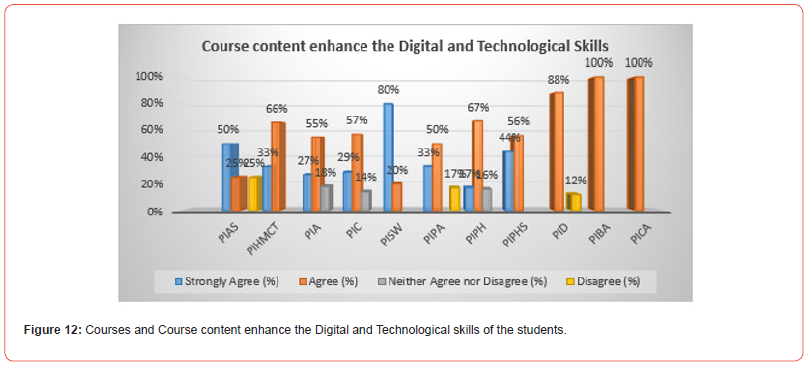
(Figure 13) It is evident from the above chart that the respondents (Teachers) from the Faculties of PIHMCT – 25%, PIA – 27%, PIC – 57%, PISW – 80%, PIPA – 17%, PIPH – 33%, PIPHS – 67% were strongly agreed and the respondents from PIAS – 25%, PIHMCT – 50%, PIA – 64%, PIC – 48%, PISW – 20%, PIPA – 67%, PIPH – 50%, PIPHS – 33%, PID – 88%, PIBA, PICA – 100% agrees that the course is suitable for employability/ higher studies/ Entrepreneurship. Whereas respondents from PIAS – 50%, PIA – 5%, PIPA, and PIPH – 17% neither agree nor disagree, though 25% of respondents from PIAS, PIHMCT, 5% from PIA, and 12% from PID are completely disagree with the above thought.
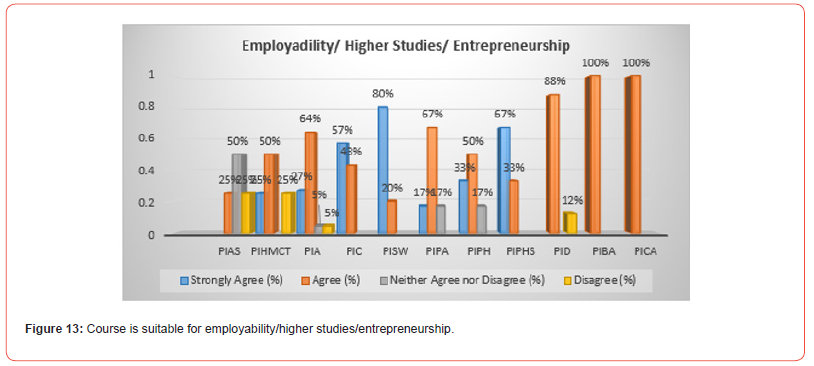
Conclusion
India is preparing to adopt the National Education Policy 2020 guidelines to reform and transform schools nationwide.
Our goal is to create a new education system that empowers young people to create new knowledge and skills, as well as human values, to address current and future challenges in civilized society through enhanced innovation and tech-savvy. Technology, based on scientific reasoning, has the potential to enhance everyone’s quality of life. Quality education serves as the foundation for this improvement. The purpose is to provide value-based, knowledgebased and skill-based higher education for everybody in the country.
The new education policy aims to enhance the quality of school and higher education, foster interest in chosen areas, and find innovative solutions to overcome challenges and achieve happiness. Quality higher education aims to educate individuals who can enhance society through value-based discipline and mutual respect, leading to progress and prosperity. Quality higher education encourages individuals to discover, adopt, and promote innovative technology that benefits society. The new researchfocused education policy aims to speed the achievement of the aforementioned objectives and empower all stakeholders to innovate.
Acknowledgment
None.
Conflict of Interest
No conflict of interest.
References
- National Education Policy 2020, Ministry of Human Resource Development, Govt. of India.
- Achieving its Objectives. International Journal of Management, Technology, and Social Sciences (IJMTS) 5(2): 19-41.
- Braun V, Clarke V (2006) Using thematic analysis in psychology. Qualitative Research in Psychology 3(2): 77-101.
- Aithal PS, Aithal S (2019) Analysis of Higher Education in Indian National Education Policy Proposal 2019 and Its Implementation Challenges. International Journal of Applied Engineering and Management Letters (IJAEML) 3(2): 1-35.
- Kumar K, Prakash A, Singh K (2020) How National Education Policy 2020 can be a lodestar to transform future generations in India. Journal of Public Affairs 21(2).
- Holloway I, Galvin K (2016) Qualitative Research in Nursing and Healthcare. John Wiley & Sons.
- Sunil Kumar Saroha, Uttam Anand (2020) New Instruction Procedure 2020 Highlights To see huge movements in schools and advanced edification. IOSR Journal of Humanities and Social Science (IOSR- JHSS) 25(8): 59-62.
- Smith J, Bekker H, Cheater F (2011) Theoretical versus pragmatic design challenges in qualitative research. Nurse Researcher 18(2): 39–51.
- Suryavanshi S (2020) Reflections from a Comparative Study for Reimagining Indian Universities. UNIVERSITY NEWS 58 (33): 96-102.
- Deb, P (2020) Vision for Foreign Universities in the National Education Policy 2020 A Critique. Rajiv Gandhi Institute for Contemporary Studies p.1-29.
- https://www.rgics.org/wpcontent/uploads/Foreign
- Aithal PS, Aithal S (2019) Building World Class Universities: Some Insights & Predictions. Building World-Class Universities Some Insights & Predictions. International Journal of Management Technology and Social Sciences (IJMTS) 4(2): 13- 35.
- Aithal PS, PM Suresh Kumar (2015) Applying SWOC Analysis to an Institution of Higher Education. International Journal of Management IT and Engineering (IJMIE) 5(7): 231-24.
-
Rajkumari Soni and Shruti Tiwari*. “Evaluating Educators’ Perspectives: A Study on Teachers’ Feedback Regarding the Implementation of the National Education Policy (NEP) 2020”. Iris J of Edu & Res. 3(1): 2024. IJER.MS.ID.000552.
-
Indian higher education policy, Implementation strategies, Indian higher education system, Research and innovation focus
-

This work is licensed under a Creative Commons Attribution-NonCommercial 4.0 International License.






